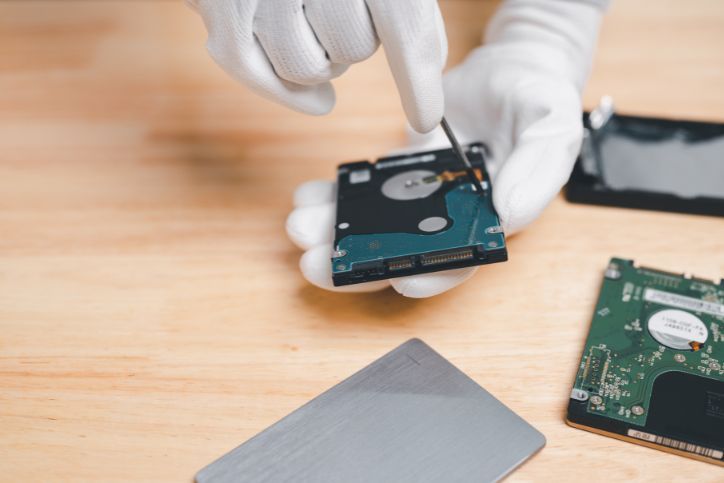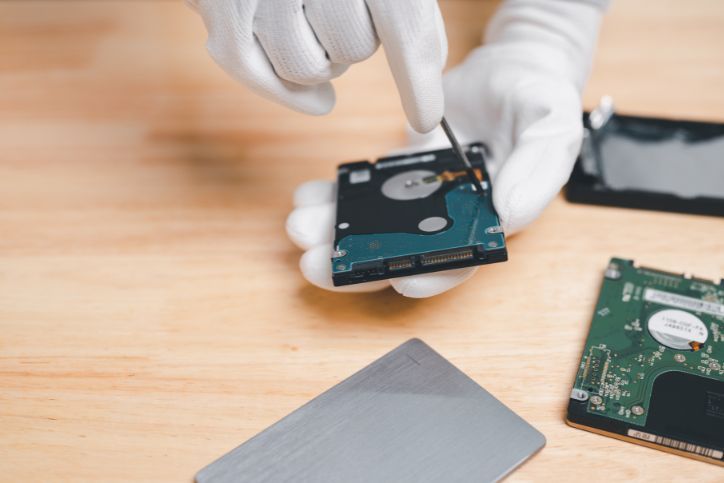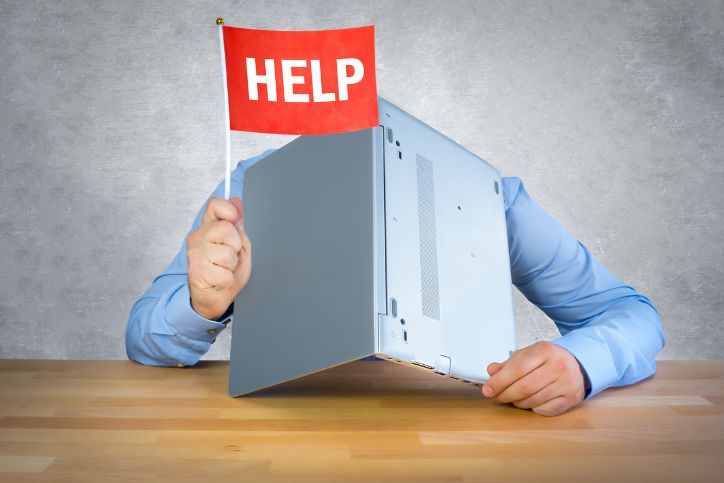How to Recover Data from a Damaged Hard Drive in Tempe

Recovering data from a damaged hard drive can feel overwhelming, but with the right steps and tools, it’s possible to retrieve your important files. In Tempe, individuals facing hard drive failures can take advantage of proven recovery methods and professional services to recover their data efficiently and safely. This guide will walk you through everything you need to know about recovering data from a damaged hard drive, from immediate actions to prevention tips.
Table of Contents
ToggleUnderstand the Causes of Hard Drive Damage
Hard drive failures happen for various reasons, and understanding the root cause is essential for determining the recovery approach. Some common causes include:
Physical Damage
Physical damage occurs when external forces harm the structure or components of the hard drive. This type of damage is often the result of mishandling or accidents, such as:
- Drops or Impacts: Dropping a laptop or external hard drive can misalign the internal parts, rendering the drive inoperable.
- Exposure to Moisture: Water spills or high humidity levels can cause internal corrosion, short circuits, or other issues.
- Heat Damage: Prolonged exposure to high temperatures can warp the components and weaken the drive’s functionality.
- Improper Handling: Mishandling the drive, such as shaking or striking it during operation, can damage sensitive parts.
Physical damage is usually easy to identify as the drive might emit strange noises or fail to power on altogether.
Logical Failures
Logical failures are less apparent and occur when there is no physical damage to the hard drive, but its data becomes inaccessible due to internal errors. Common causes include:
- File Corruption: Power interruptions during file transfers or system crashes can corrupt data and make it unreadable.
- Malware or Viruses: Malicious programs can delete, encrypt, or corrupt files, rendering them inaccessible without specialized recovery tools.
- Software Errors: Faulty updates or operating system bugs can disrupt the normal operation of the hard drive, causing logical failures.
- Improper Ejection: Removing an external drive without safely ejecting it can lead to logical damage over time.
Logical failures often manifest as missing files, error messages, or the inability to access certain folders.
Mechanical Failures
Mechanical failures are caused by the wear and tear of internal components or defects in manufacturing. These failures are often serious and can result in complete hard drive failure. Key mechanical issues include:
- Worn-Out Motors: The motor that spins the disk may degrade over time, stopping the drive from functioning.
- Malfunctioning Read/Write Heads: If the tiny heads that read or write data to the disk are misaligned or damaged, the drive cannot access or save files.
- Degraded Components: Over time, internal parts like the spindle or actuator arm can deteriorate, leading to permanent data loss.
Signs of mechanical failures include clicking, grinding, or buzzing noises coming from the drive. These failures often require professional intervention to retrieve data.
Environmental Factors
The environment plays a critical role in the health of your hard drive. In places like Tempe, environmental challenges can exacerbate the risk of hard drive damage. Examples include:
- Dust and Debris: Dust particles can infiltrate the drive and scratch the delicate disk surfaces, leading to data loss.
- High Humidity: Although Tempe has a dry climate, sudden changes in humidity, such as during monsoon season, can create moisture inside the drive and cause corrosion.
- Power Surges: Power fluctuations during summer storms or high-energy demand periods can damage the drive’s electrical components.
- Temperature Extremes: In the desert climate of Tempe, leaving a hard drive in a hot car or exposed to direct sunlight can warp its components and lead to failure.
According to Geeks2You, being aware of these causes can help you take appropriate recovery measures and avoid further complications.
Immediate Steps to Take
When you suspect your hard drive is damaged, taking quick and deliberate action can significantly improve your chances of recovering data. Follow these steps:
- Stop Using the Drive Immediately
Continuing to use a damaged drive can overwrite existing files, making recovery more difficult. If you notice unusual noises, errors, or crashes, stop using it right away. - Avoid DIY Repairs
While it might be tempting to open the drive or attempt fixes using online tutorials, doing so can worsen the problem. Recovery requires precision tools and expertise from professionals like Geeks2You. - Disconnect the Drive
Power down your computer and disconnect the hard drive. Keeping the drive inactive prevents additional damage and data loss. - Backup Any Accessible Data
If the drive is partially accessible, create backups of all the files you can still retrieve. Use external storage or cloud-based platforms like Google Drive to store these backups securely.
Methods for Data Recovery
There are multiple methods for recovering data from a damaged hard drive, ranging from DIY solutions to professional services.
1. Use Data Recovery Software
Data recovery software is an affordable option for logical damage or minor issues. These programs scan your hard drive for recoverable files and help retrieve them.
- Popular Tools:
- Disk Drill
- EaseUS Data Recovery Wizard
- Stellar Data Recovery
- Recuva
- How to Use Recovery Software:
- Install the software on a functioning computer, not the damaged hard drive.
- Connect the damaged drive as an external device.
- Launch the software and follow its instructions to scan the drive for recoverable files.
- Save the retrieved files to a separate location.
- Benefits:
- Affordable and accessible.
- Effective for logical errors and accidental file deletions.
However, recovery software is not always the best option for physical or mechanical damage.
2. Seek Professional Data Recovery Services
For hard drives with physical or severe mechanical issues, professional help is the safest and most effective choice when it comes to data recovery. In Tempe, Geeks2You offers reliable hard drive recovery services tailored to different types of damage.
- Why Choose Professional Services?
- Specialized equipment for handling internal components.
- Expertise in recovering data from drives with extensive damage.
- Higher success rates compared to software.
- When to Contact a Professional:
- The hard drive emits strange noises (clicking or grinding).
- The drive is not detected by your computer.
- Files are missing after accidental formatting.
Professionals like Geeks2You have the tools and knowledge to recover your valuable data while minimizing risks.
How to Choose the Right Recovery Method
Deciding between software and professional services depends on the nature of the damage:
- Logical Failures: Use software to scan and recover data.
- Physical or Mechanical Damage: Opt for professional recovery services to prevent further damage.
Consider reaching out to Geeks2You in Tempe for an assessment if you’re unsure about the severity of the issue.
Tips to Prevent Future Data Loss
Preventing hard drive damage and ensuring the safety of your data is crucial. Adopt these strategies to protect your files:
- Regular Backups
- Use external hard drives, USB devices, or cloud storage solutions like Google Drive or OneDrive to create routine backups.
- Automate your backups with software to ensure consistency.
- Install Surge Protectors
- Protect your electronics from power surges and fluctuations, which can damage internal components.
- Monitor Drive Health
- Use tools like CrystalDiskInfo to monitor your hard drive’s health and detect potential issues early.
- Handle Drives with Care
- Avoid sudden movements, drops, or exposure to extreme temperatures and moisture.
- Invest in an SSD (Solid-State Drive)
- SSDs are less prone to mechanical failure compared to traditional hard drives. While more expensive, they provide better reliability and faster performance.
Final Thoughts
Recovering data from a damaged hard drive requires a strategic approach. Start by identifying the type of damage and choosing the appropriate recovery method. While software can handle logical errors, professional services like Geeks2You in Tempe are your best bet for physical or mechanical issues. Remember to back up your files regularly and take precautions to safeguard your hard drives from future damage.
Take action today—contact Geeks2You to restore your data and get peace of mind knowing your important files are safe.
FAQs
How do I know if my hard drive is physically damaged?
According to the professionals from Geeks2You, physical damage is often indicated by unusual noises (clicking, grinding) or the drive not being detected by your computer.
Can all data be recovered from a damaged hard drive?
Successful data recovery depends on the extent of the damage. Logical issues have higher recovery rates compared to severe physical damage.
Is it safe to use data recovery software on a damaged drive?
It’s safe for logical issues, but avoid using software if the drive shows signs of physical damage to prevent further harm. Contact us to learn more.
Instant Quote
Get A FREE Quote IMMEDIATELY
Other Blogs You May Be Interested In
Categories
Satisfaction Guaranteed
Computer Repair You Can Trust













